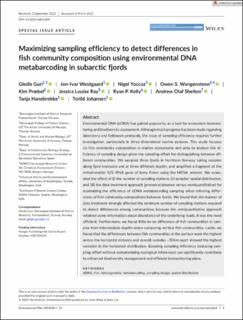| dc.description.abstract | Environmental DNA (eDNA) has gained popularity as a tool for ecosystem biomonitoring and biodiversity assessment. Although much progress has been made regarding laboratory and fieldwork protocols, the issue of sampling efficiency requires further investigation, particularly in three-dimensional marine systems. This study focuses on fish community composition in marine ecosystems and aims to analyze the efficiency of sampling design given the sampling effort for distinguishing between different communities. We sampled three fjords in Northern Norway, taking samples along fjord transects and at three different depths, and amplified a fragment of the mitochondrial 12S rRNA gene of bony fishes using the MiFish primers. We evaluated the effect of (i) the number of sampling stations, (ii) samples' spatial distribution, and (iii) the data treatment approach (presence/absence versus semiquantitative) for maximizing the efficiency of eDNA metabarcoding sampling when inferring differences of fish community compositions between fjords. We found that the manner of data treatment strongly affected the minimum number of sampling stations required to detect differences among communities; because the semiquantitative approach retained some information about abundance of the underlying reads, it was the most efficient. Furthermore, we found little-to-no difference of fish communities in samples from intermediate depths when comparing vertical fish communities. Lastly, we found that the differences between fish communities at the surface were the highest across the horizontal distance and overall, samples ~30 km apart showed the highest variation in the horizontal distribution. Boosting sampling efficiency (reducing sampling effort without compromising ecological inferences) can significantly contribute to enhanced biodiversity management and efficient biomonitoring plans. | en_US |
